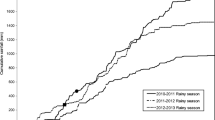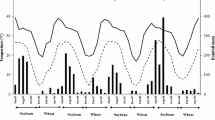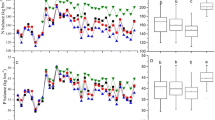Abstract
The beneficial role of green manures in rice production is generally ascribed to their potential of supplying plant nutrients, particularly nitrogen (N). However, the mechanisms through which green manures enhance the crop productivity are poorly understood. Pot experiments were conducted using a 15N-tracer technique: (1) to compare the biomass production potential of sesbania (Sesbania aculeata Pers.) and maize (Zea mays L.) as green manuring crops for lowland rice and (2) to compare the effect of the two types of green manure and inorganic N on the dry matter accumulation and N uptake by two rice (Oryza sativa L.) cultivars, viz. IR-6 and Bas-370. Although maize produced three times higher shoot biomass compared with sesbania, the latter showed higher N concentration; and thus the total N yield was similar in the two types of plants. Applying the shoot material of the two plants to flooded rice significantly enhanced the dry matter yield and N uptake by the two rice cultivars, the positive effects generally being more pronounced with sesbania than with maize amendment. The difference in the growth-promoting potential of the two plant residues was related more to an increased uptake of the native soil N rather than to their direct role as a source of plant-available N. A positive added nitrogen interaction (ANI) was observed due to both plant residues, the effect was much more pronounced with the application of sesbania than with maize residues. In both rice cultivars, inorganic N also caused a substantial ANI, particularly at higher application rate. Losses from the applied N were 2–3 times lower from sesbania, compared with maize treatment. Green manuring with sesbania also caused much lower N losses than the inorganic N applied at equivalent or higher rates. The overall benefit of green manuring to rice plants was higher than inorganic N applied at comparable rates. The two rice cultivars differed in their response to green manuring, IR-6 generally being more responsive than Bas-370.
Similar content being viewed by others
References
Aulakh MS, Khera TS, Doran JW, Singh K, Singh B (2000a) Yield and nitrogen dynamics in a rice-wheat system using green manure and inorganic fertilizer. Soil Sci Soc Am J 64:1867–1876
Aulakh MS, Khera TS, Doran JW (2000b) Mineralization and denitrification in upland, nearly saturated and flooded subtropical soil. II. Effect of organic manures varying in N content and C:N ratio. Biol Fert Soils 31:168–174
Azam F, Ashraf M, Lodhi A, Sajjad MI (1992) Fate and interaction with native soil N of ammonium N applied to wetland rice (Oryza sativa L.) grown under saline and non-saline conditions. Biol Fert Soils 13:102–107
Azam F, Simmons FW, Mulvaney RL (1993) Mineralization of N from plant residues and its interaction with native soil N. Soil Biol Biochem 25:1787–1792
Becker M, Diekman KH, Ladha JL, De Datta SK, Ottow JCG (1991) Effect of NPK on growth and nitrogen fixation of Sesbania rostrata as green manure for low-land rice (Oryza sativa L.). Plant Soil 132:149–158
Biederbeck VO, Campbell CA, Rasiah V, Zentner RP, Wen G (1998) Soil quality attributes as influenced by annual legumes used as green manure. Soil Biol Biochem 30:1177–1185
Bremner JM, Mulvaney CS (1982) Nitrogen-total. In: Page AL, Miller RH, Keeney DR (eds) Methods of soil analysis, part 2, 2nd edn. ASA/SSSA, Madison, pp 595–662
Bruulsema TW, Christie BR (1987) Nitribution contribution to succeeding corn from alfalfa and red clover. Agron J 79:96–100
Chalk PM, Victoria RL, Murarka T, Piccolo MC (1990) Effect of nitrification inhibitor on nitrification and mineralization of soil and fertilizer nitrogen. Soil Biol Biochem 22:533–538
De Datta SK, Buresh RJ (1989) Integrated nitrogen management in irrigated rice. Adv Soil Sci 10:143–164
Diekman KH, Ottow JCG, De Datta SK (1993) Nitrogen uptake and recovery from urea and green manure in low land rice measured by 15N and non-isotopic techniques. Plant Soil 148:91–99
Fox RH, Myers RJK, Vallis I (1990) The nitrogen mineralization rate of legume residues in soil as influenced by their polyphenol, lignin and nitrogen contents. Plant Soil 129:251–259
Ghai SK, Rao DLN, Batra L (1988) Nitrogen contribution to wetland rice by green manuring with Sesbania spp in an alkaline soil. Biol Fert Soils 6:22–25
Gomez KA, Gomez AA (1984) Statistical procedures for agricultural research. Wiley, Singapore
Hart PBS, Rayner JH, Jenkinson DS (1986) Influence of pool substitution on the interpretation of fertilizer experiments with 15N. J Soil Sci 37:389–403
Hauck RD (1982) Nitrogen-isotope-ratio analysis. In: Page AL, Miller RH, Keeney DR (eds) Methods of soil analysis, part 2, 2nd edn. ASA/SSSA, Madison, pp 735–779
Hood R (2001) Evaluation of a new approach to the nitrogen-15 isotope dilution technique, to estimate crop N uptake from organic residues. Biol Fert Soils 34:156–161
Jenkinson DS, Fox RH, Rayner JH (1985) Interactions between fertilizer nitrogen and soil nitrogen—the so-called “priming” effect. J Soil Sci 36:425–444
Koyama T, Chammek C, Niamtrichand (1973) Nitrogen application technology for tropical rice as determined by field experiments using 15N tracer techniques. Tech Bull Trop Agric Res Cent (Jpn) 3:1–79
Ladd JN, Amato M, Jackson RB, Butler JHA (1983) Utilization by wheat plants of nitrogen from legume residues decomposing in soils in the field. Soil Biol Biochem 15:231–238
Morris RA, Furoc RE, Rajbhandari NK, Marqueses EP, Dizon MA (1989) Rice response to waterlog-tolerant green manures. Agron J 81:803–809
Palm CA, Sanchez PA (1991) Nitrogen release from some tropical legume as affected by lignin and polyphenol contents. Soil Biol Biochem 23:83–88
Prasad R, De Datta SK (1979) Increasing efficiency of fertilizer nitrogen in wetland rice. In: International Rice Research Institute (ed) Nitrogen and rice. International Rice Research Institute, Los Banos, pp 465–484
Rao VR (1978) Effect of carbon source on asymbiotic nitrogen fixation in a paddy soil. Soil Biol Biochem 10:319–321
Roper MM (1985) Straw decomposition and nitrogenase activity (C2H2 reduction): effects of soil moisture and temperature. Soil Biol Biochem 17:65–71
Smith MS, Frye WW, Varco JJ (1987) Legume winter cover crops. Adv Soil Sci 7:95–139
Thönnissen C, Midmore DJ, Ladha JK, Holmer RJ, Schmidhalter U (2000) Tomato crop response to short-duration legume green manures in tropical vegetable systems. Agron J 92:245–253
Torbert HA, Mulvaney RL, Vanden Heuvel RM, Hoeft RG (1992) Soil type and moisture regime effects on fertilizer calculation methods in a nitrogen-15 tracer study. Agron J 81:236–241
Ventura W, Watanabe I (1993) Green manure production of Azolla microphylla and Sesbania rostrata and their long-term effects on rice yield and soil fertility. Biol Fert Soils 15:241–248
Westcott MP, Mikkelsen DS (1985) Comparative effects of an organic and inorganic nitrogen source in flooded rice. Soil Sci Soc Am J 49:1470–1475
Woods LE, Cole CV, Porter LK, Coleman DC (1987) Transformations of added and indigenous nitrogen in gnotobiotic soil: a comment on priming effect. Soil Biol Biochem 19:673–678
Acknowledgements
The authors thank Muzzafar H. Sajjad and Ansar Mahmood for their valuable technical assistance. An equipment grant by the Alexander-von-Humboldt Foundation, Germany, is also sincerely acknowledged.
Author information
Authors and Affiliations
Corresponding author
Rights and permissions
About this article
Cite this article
Ashraf, M., Mahmood, T., Azam, F. et al. Comparative effects of applying leguminous and non-leguminous green manures and inorganic N on biomass yield and nitrogen uptake in flooded rice (Oryza sativa L.). Biol Fertil Soils 40, 147–152 (2004). https://doi.org/10.1007/s00374-004-0756-0
Received:
Revised:
Accepted:
Published:
Issue Date:
DOI: https://doi.org/10.1007/s00374-004-0756-0




